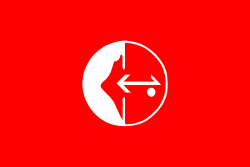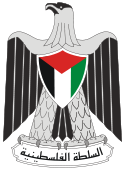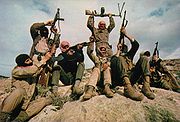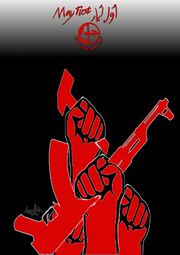Popular Front for the Liberation of Palestine
| Popular Front for the Liberation of Palestine الجبهة الشعبية لتحرير فلسطين |
|
|---|---|
 |
|
| Founder | George Habash |
| General Secretary | Ahmad Sa'adat |
| Founded | 1967 |
| Headquarters | Ramallah |
| Ideology | Socialism, Marxism-Leninism, left-wing Palestinian nationalism, anti-Zionism, one-state solution |
| International affiliation | formerly affiliated to the Arab Socialist Action Party |
| Website | |
| www.pflp.ps | |
| Palestinian National Authority |
 This article is part of the series: |
|
|
1 On June 14, 2007, President Mahmoud Abbas dismissed Haniyeh's government and appointed Fayyad to form an emergency government. However, Haniyeh and Hamas maintain that these actions were illegal and that Haniyeh is still the Prime Minister. Haniyeh still exercises de facto authority in the Gaza Strip, while Fayyad's authority is limited de facto to the West Bank. |
|
Other countries · Atlas |


The Popular Front for the Liberation of Palestine (PFLP) (Arabic: الجبهة الشعبية لتحرير فلسطين, al-Jabhah al-Sha`biyyah li-Taḥrīr Filasṭīn) is a Palestinian Marxist national liberation movement, founded in 1967. It has consistently been the second-largest of the groups forming the Palestine Liberation Organization (PLO), the largest being Fatah.
The PFLP has generally taken a hard line on Palestinian national aspirations, opposing the more moderate stance of Fatah. It has been described as a terrorist organization by the United States government and the European Union.[1] It opposes negotiations with the Israeli government, and favours a one-state solution to the Israeli–Palestinian conflict. The military wing of the PFLP is called the Abu Ali Mustapha Brigades.
Contents |
History of the PFLP
Origins in the ANM
The PFLP grew out of the Harakat al-Qawmiyyin al-Arab, or Arab Nationalist Movement (ANM), founded in 1953 by Dr. George Habash, a Palestinian Christian, from Lydda.
In 1948, 19 year old Habash, a medical student, went to his home town of Lydda during the 1948 Arab-Israeli War to help his family. While he was there, the Israel Defence Forces attacked the city and expelled its civilian population, who were forced to march for three days without food or water until they reached the Arab front lines. Israeli historian Benny Morris writes that "all the Israelis who witnessed the events agreed that the exodus, under a hot July sun, was an extended episode of suffering for the refugees, especially from Lydda...Some were stripped by soldiers of their valuables as they left town or at checkpoints along the way. Hundreds of civilians died in the scorching heat, from exhaustion, dehydration and disease.[2][3]
Habash finished his medical education in Lebanon at the American University in Beirut, graduating in 1951.[4]
In an interview with US journalist John Cooley, Habash identified the Arab defeat by Israel as "the scientific society of Israel as against our own backwardness in the Arab world. This called for the total rebuilding of Arab society into a twentieth-century society," (Cooley 1973:135).
The ANM was founded in this nationalist spirit. "[We] held the 'Guevara view' of the 'revolutionary human being'," Habash told Cooley. "A new breed of man had to emerge, among the Arabs as everywhere else. This meant applying everything in human power to the realization of a cause." (ibid.)
Formation of the PFLP
The ANM formed underground branches in several Arab countries, including Libya, Saudi Arabia and Kuwait, then still under British rule. It adopted secularism and socialist economic ideas, and pushed for armed struggle. In collaboration with the Palestinian Liberation Army, the ANM established Abtal al-Audah, Heroes of the Return, as a commando group in 1966. After the Six Day War of June 1967, this group merged in August with two other groups, Youth for Revenge and Ahmed Jibril's Syrian-backed Palestine Liberation Front, to form the PFLP, with Habash as leader.
By early 1968, the PFLP had trained between one and three thousand guerrillas. It had the financial backing of Syria, and was headquartered there, and one of its training camps was based in as-Salt, Jordan. In 1969, the PFLP declared itself a Marxist-Leninist organization, but it has remained faithful to Pan Arabism, seeing the Palestinian struggle as part of a wider uprising against Western imperialism, which also aims to unite the Arab world by overthrowing "reactionary" regimes. It published a newspaper, al-Hadaf (The Target, or Goal), which was edited by Ghassan Kanafani.
Breakaway organizations
In 1968, Ahmed Jibril broke away from the PFLP to form the Syrian-backed Popular Front for the Liberation of Palestine - General Command (PFLP-GC).
In 1969, the Democratic Front for the Liberation of Palestine (DFLP) formed as a separate, ostensibly Maoist, organization under Nayef Hawatmeh and Yasser Abd Rabbo, initially as the PDFLP.
In 1972, the Popular Revolutionary Front for the Liberation of Palestine was formed following a split in PFLP.
The PFLP had a troubled relationship with George Habash's one-time deputy, Wadie Haddad, who was eventually expelled because he refused orders to stop attacks and kidnapping operations abroad.
PLO membership
The PFLP joined the Palestine Liberation Organization (PLO), the umbrella organization of the Palestinian national movement, in 1968, becoming the second-largest faction after Yassir Arafat's Fatah. In 1974, it withdrew from the organization's executive committee (but not from the PLO) to join the Rejectionist Front, accusing the PLO of abandoning the goal of destroying Israel outright in favor of a binational solution, which was opposed by the PFLP leadership. It rejoined the executive committee in 1981.
After the Oslo Accords
After the eruption of the First Intifada and the subsequent Oslo Accords the PFLP had difficulty establishing itself in the West Bank and Gaza Strip. The boycott of the 1996 elections gave many the impression that the PFLP was irrelevant to developments in Palestine. At that time (1993–96) Hamas enjoyed rapidly rising popularity in the wake of their successful strategy of suicide bombings devised by Yahya Ayyash ("the Engineer"). Also, the fall of the Soviet Union together with the rise of Islamism — and particularly the increased popularity of the Islamist groups Hamas and Palestinian Islamic Jihad — disoriented many left activists who looked towards the Soviet Union, and has marginalised the PFLP's role in Palestinian politics and armed resistance. However, the organization retains considerable political influence within the PLO, since no new elections have been held for the organisation's legislative body, the PNC.
As a result of its post-Oslo weakness, the PFLP has been forced to adapt slowly and find partners among politically active, preferably young, Palestinians in the West Bank and Gaza, in order to compensate for their dependence on their aging commanders returning from or remaining in exile. The PFLP has therefore formed alliances with other leftist groups formed within the Palestinian Authority, including the Palestinian People's Party, the Popular Resistance Committees of Gaza.
In 1990, the PFLP transformed its Jordan branch into a separate political party, the Jordanian Popular Democratic Unity Party.
Elections in the PNA
Following the death of Yasser Arafat in November 2004, the PFLP entered discussions with the DFLP and the Palestinian People's Party aimed at nominating a joint left-wing candidate for the presidential elections. These discussions were unsuccessful, and the PFLP then decided to support the independent Palestinian National Initiative's candidate Mustafa Barghouti, who gained 19.48% of the vote. In the municipal elections of December 2005 it had more success, e.g. in al-Bireh and Ramallah, and winning the mayorship of Bir Zeit. [1] There are conflicting reports about the political allegiance of Janet Mikhail and Victor Batarseh, the mayors of Ramallah and Bethlehem, they may be close to the PFLP without being members.
The PFLP is powerful politically in the Ramallah area, the eastern districts and suburbs of Jerusalem and Bethlehem, the primarily Christian Refidyeh district of Nablus, but has far less strength in the rest of the West Bank, and is of little or no threat to the established Hamas and Fatah movements in Gaza.
The PFLP participated in the Palestinian legislative elections of 2006 as the "Martyr Abu Ali Mustafa List". It won 4.2% of the popular vote and took three of the 132 seats in the Palestinian Legislative Council. Its deputies are Ahmad Sa'adat, Jamil Majdalawi, and Khalida Jarrar. In the lists, its best vote was 9.4% in Bethlehem, followed by 6.6% in Ramallah and al-Bireh, and 6.5% in North Gaza.
Successors to George Habash
At the PFLP's Sixth National Conference in 2000, Habash stepped down as general secretary. Abu Ali Mustafa was elected to replace him, but was assassinated on 27 August 2001 when an Israeli helicopter fired rockets at his office in the West Bank town of Ramallah. The PFLP shot and killed the right-wing nationalist Israeli Tourism Minister Rehavam Zeevi in 17 November 2001 in retaliation.
After Mustafa's death, Ahmad Sa'adat was elected general secretary on 3 October 2001. In January 2002, he was arrested by the Palestinian Authority under pressure from the United States and the United Kingdom and imprisoned in Jericho prison along with several other PFLP members accused by Israel of involvement in the Zeevi assassination. The Palestinian High Court ordered his release, stating that there were no legal grounds for the imprisonment, but the Palestinian National Authority refused to implement the court's decision. On 14 March 2006, the Israel Defense Forces attacked the prison and, after a 10-hour siege resulting in the death of two people and the wounding of 35, removed Sadat and five other inmates, arrested them, and took them to Israel for trial.
Attitude to the peace process
When it was formed in the late 1960s the PFLP supported the established line of most Palestinian guerrilla fronts and ruled out any negotiated settlement with Israel that would result in two states between the Jordan River and the Mediterranean Sea. Instead, George Habash in particular, and various other leaders in general advocated one state with an Arab identity in which Jews were entitled to live with the same rights as any minority.
The PFLP platform never wavered on key points such as the overthrow of conservative or monarchist Arab states like Morocco and Jordan, the Right of Return of all Palestinian refugees to their homes in pre-1948 Palestine, or the use of the liberation of Palestine as a launching board for achieving Arab unity – reflecting its beginnings in the Pan-Arab ANM. It opposed the Oslo Accords and was for a long time opposed to the idea of a two-state solution to the Israeli-Palestinian conflict, but in 1999 came to an agreement with the PLO leadership regarding negotiations with the Israeli government. However, in May 2010, PFLP general secretary Ahmad Sa'adat called for an end to the PLO's negotiations with Israel, saying that only a one-state solution was possible. [2]
Membership profile
The PFLP's armed wing, in the West Bank and Gaza, the Abu Ali Mustapha Brigades, draws much of its support from student organizations in universities like Al-Quds University (eastern Jerusalem), Bir Zeit University (Ramallah area), An-Najah National University (Nablus), and the Arab American University - Jenin. The movement has thousands of active or passive activists in the West Bank, and a few hundred behind bars in Israeli prisons. In December 2009, around 70,000 supporters demonstrated in Gaza to celebrate the PFLP's 42nd anniversary. [3] The PFLP's leader in Gaza is Dr. Rabah Muhanna. [4]
Armed attacks of the PFLP
This is a list of armed attacks attributed to the PFLP. It is not complete.
Armed attacks before 2000
The PFLP gained notoriety in the late 1960s and early 1970s for a series of armed attacks and aircraft hijackings, including on non-Israeli targets:
- The hijacking of an El Al flight from Rome to Lod airport in Israel on 23 July 1968. The Western media reported that the flight was targeted because the PFLP believed Israeli general Yitzhak Rabin, who was Israeli ambassador to the USA, was on board. Several individuals involved with the hijacking, including Leila Khaled deny this. The plane was diverted to Algiers, where 21 passengers and 11 crew members were held for 39 days, until August 31;
- Gunmen opened fire on an El Al passenger jet in Athens about to take off for New York on 26 December 1968, killing one Israeli mechanic;
- An attack on El Al passengers jet at Zürich airport on 18 February 1969, killing the co-pilot and wounding the pilot;
- The bombing of a Jerusalem supermarket on 20 February 1969, killing two Israelis and wounding twenty others;
- The hijacking of a TWA flight from Los Angeles to Damascus on 29 August 1969 by a PFLP cell led by Leila Khaled, who became the PFLP's most famous recruit. Two Israeli passengers were held for 44 days;
- Three adult Palestinians and three boys aged 14 and 15 years old threw grenades at the Israeli embassies in The Hague, Bonn and the El Al office in Brussels on the same day, 9 September 1969 with no casualties;
- Attack on a bus containing El Al passengers at Munich airport, killing one passenger and wounding 11 on 10 February 1970;
- The bombing, with a barometric pressure device, of a Swissair flight bound for Israel, killing 47, on 21 February 1970; for details see Swissair Flight 330.
- On 6 September 1970, the PFLP (including Leila Khaled) hijacked four passenger aircraft from Pan Am, TWA and Swissair on flights to New York from Brussels, Frankfurt and Zürich; and on 9 September 1970, hijacked a BOAC flight from Bahrain to London via Beirut. The Pan Am flight was diverted to Cairo; the TWA, Swissair and BOAC flights were diverted to Dawson's Field in Zarqa, Jordan. The TWA, Swissair and BOAC aircraft were subsequently blown up by the PFLP on September 12, in front of the world media, after all passengers had been taken off the planes. The event is significant, as it was cited as a reason for the Black September clashes between Palestinian and Jordanian forces.
- On May 30, 1972, 28 passengers were gunned down at Ben Gurion International Airport by members of the Japanese Red Army in collaboration with the PFLP in what became known as the Lod Airport massacre.
- On October 13, 1977, the PFLP hijacked Lufthansa flight LH181, a Boeing 737 flying from Palma de Mallorca to Frankfurt. After various stopovers the pilot was killed. The remaining passengers and crew were eventually rescued by German counter-terrorism special forces see Mogadishu hijacking.
- On 3 October 1980 four people were killed and dozens injured in the 1980 Paris synagogue bombing.[5]
- On 12 April 1984 a bus from Tel Aviv was hijacked. Bassam Abu Sharif in Damascus issued a statement in the name of the PFLP claiming responsibility.[6]
The PFLP's Abu Ali Mustapha Brigades has carried out attacks on both civilians and military targets during the Al-Aqsa Intifada. Some of these attacks are:
- The killing of Meir Lixenberg, councillor and head of security in four settlements, who was shot while travelling in his car in the West Bank on 27 August 2001. PFLP claimed that this was a retaliation for the killing of Abu Ali Mustafa.[7]
- The 21 October 2001 assassination of Israeli Minister for Tourism Rehavam Zeevi by Hamdi Quran, the only Israeli politician to have been assassinated in the Second Intifada.
- A suicide bombing in a pizzeria in Karnei Shomron, on the West Bank on 16 February 2002, killing three Israeli settlers.[7]
- A suicide bombing in Ariel on 7 March 2002, which left wounded but no fatalities.
- A suicide bombing in a Netanya market in Israel, on 19 May 2002, killing three Israelis. This attack was also claimed by Hamas[7], but the Abu Ali Mustafa Brigades have identified the perpetrator on their website as one of their members [5][6]
- A suicide bombing in the bus station at Geha Junction in Petah Tikva on 25 December 2003 which killed 4 Israelis. [7]
- A suicide bombing in Bikat Hayerden on 22 May 2004 , which left no fatalities. [8]
- A suicide bombing in the Carmel Market in Tel Aviv on 1 November 2004 , which killed 3 Israeli civilians. [9]
Attitude to the 2007 Fatah Hamas Conflict
The PFLP opposed the conflict between Hamas and Fatah and believes that the Salam Fayad government is not helpful in solving the conflict.[8]
See also
- Arab Socialist Action Party
- List of political parties in the Palestinian National Authority
- Palestinian domestic weapons production
- Rejectionist Front
- Carlos the Jackal
- Revolutionare Zellen
- Japanese Red Army
- DFLP
- Palestinian Islamic Jihad
- Hamas
- Palestinian Popular Struggle Front
External links
- PFLP's official site
- PFLP's official site in English version
- Interview with imprisoned PFLP General Secretary Ahmad Saadat- Fight Back! News, Summer 2003
References
- ↑ http://eur-lex.europa.eu/LexUriServ/site/en/oj/2005/l_340/l_34020051223en00640066.pdf
- ↑ Benny Morris (1987). The Birth of the Palestinian Refugee Problem, 1947-1949. Cambridge University Press. pp. 203–11. ISBN 0-521-33889-1.
- ↑ The Lydda Death March Americans for Middle East Understanding
- ↑ Kazziha, Walid, Revolutionary Transformation in the Arab World: Habash and his Comrades from Nationalism to Marxism. p. 17–18
- ↑ "Synagogue Bomb Suspect Arrested". ABC News. November 13, 2008. http://abcnews.go.com/Blotter/story?id=6249760&page=1.
- ↑ The Times (London), 14 April 1984. Robert Fisk.
- ↑ 7.0 7.1 7.2 ISRAEL AND THE OCCUPIED TERRITORIES AND THE PALESTINIAN AUTHORITY. Without distinction - attacks on civilians by Palestinian armed groups, Amnesty International, July 11, 2002.
- ↑ PFLP: New Gov't Not Helpful
- Green March Black September: The Story of the Palestinian Arabs by John K. Cooley, Frank Cass & Co,. Ltd., London 1973
- 'Popular Front for the Liberation of Palestine (PFLP)' from Country Reports on Terrorism, 2004. United States Department of State, April 2005. http://www.state.gov/s/ct/rls/45394.htm http://library.nps.navy.mil/home/tgp/pflp.htm, http://library.nps.navy.mil/home/tgp/pflp.htm
- [10], [11], [12] Secret documents regarding 1974 cooperation between the KGB and the PFLP against Israel and arming PFLP – (in Russian) from the Soviet Archives [13] collected by Vladimir Bukovsky
|
||||||||
|
||||||||||||||